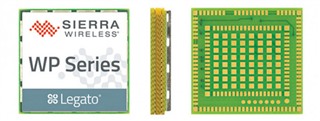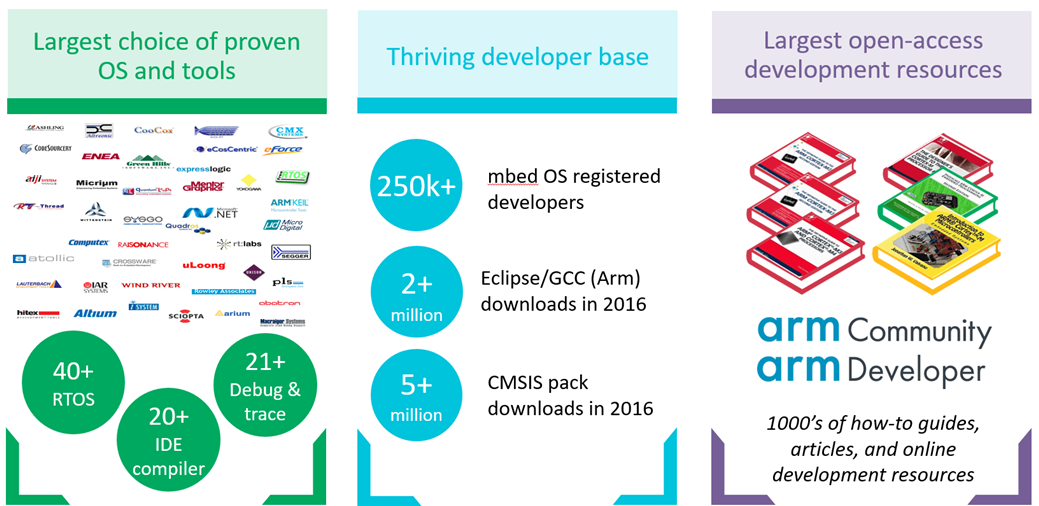The Arm Internet of Things (IoT) Continuum
This blog explains how Arm and its ecosystem provide the breadth of technology solutions to help you get your IoT product to market quickly and protect your software investment.

It was October when I sat at the Arm TechCon 2017 event and watched the always-thought-provoking keynote from Mike Muller, Arm’s CTO. Mike was talking about a heart attack prevention device that monitors the thickness of your ankles. Ankle swelling can be an early indicator of a patient’s increased risk of a heart attack, and informs them they should seek preventative medical help. When the device was opened, it contained a Raspberry Pi board. This made me think about how the barriers of entry have dropped considerably for getting innovative products to market.
This blog looks at the range of hardware options for IoT – what we are calling the “IoT Continuum” - and how Arm and partners provide the breadth of technology solutions to help you get to market quickly and protect your software investment as your business grows.
Why does the IoT Continuum matter?
In the past, to design a prototype required extensive hardware and software knowledge often not available to companies in the start-up or experimental phases. The key to innovation in the IoT space is the ability to experiment quickly and adapt to the market. The IoT space does not tolerate long product development cycles. To be successful, you need to be able to introduce products quickly, and evolve with the market needs.
To bring a design to market typically requires both hardware and software. Key enablers to address the speed of the IoT market are frameworks, services and tools to make it quicker and easier to develop your solution. Working with a range of people, including communities of like-minded people, or experienced design houses, can help design the exact solution you need.
Single-board computers
Let’s begin at one of the most popular starting points for turning an innovative idea into a reality: single-board computers. Toradex, Next Thing Co and Raspberry Pi are leading examples of Arm-based boards that can be bought to accelerate this initial development. These provide a wide range of functionality within a compact, production-ready board. Some were initially designed as education tools or to enable makers to start development, however, more production devices are now using these boards at the core of their product. An example of a company adopting this approach is Dakboard, who have a range of connected displays, using the Raspberry Pi as their main controller board. This frees Dakboard to focus on their key differentiator: the services that they offer providing weather updates, calendar syncs and photo management.
Getting started is not solely about the hardware. A wide ecosystem has been developed around a range of frameworks, libraries and tools to enable easy creation of the initial software. An example of this is a recent collaboration between Google and Raspberry Pi; the Voice HAT (Hardware Accessory on Top) board allows users to easily introduce voice control to their projects. This opens up the opportunity for innovators to access the wide range of Google’s SDKs to enable them to bring voice activation to their IoT solution.
System components

Fundamentally, IoT systems are about sensing, and processing with connectivity to a cloud service. These can be built up in a variety of ways – either by adding in modules to existing devices or adopting IoT platforms, which provide a more comprehensive software stack, as well as the hardware.
The key aspect of the system components approach is the inclusion of both the required hardware and software stacks, bundled together for ease of use. There are a wide variety of modules and platforms available, so that you can find a combination to meet your specific requirements – no matter how simple or complex they need to be.
Modules
There is a large selection of options open to companies at these early stages. Some companies will find small module boards provide them with the required additional functionality they need to add to existing products. For example, the addition of a Bluetooth-enabled module can turn a standalone sensing device into a connected device.
Most companies, with a working device or concept, will move on to develop their concept further. Areas they can enhance further are improved performance, tailored functionality for their market, reduced costs or the introduction of new features to differentiate their solution. The advantage with the Arm IoT Continuum is that companies can transition to more tailored solutions without having to throw away the work they have already done on their software. The ability to have consistency in the toolchain enables, not only reuse of already developed software, but also increased efficiency that familiar development tools bring to a project.
The first step in this direction can be the reuse of small modules that have more specific functionality, which can give you the flexibility to mix-and-match features or move to off-the-shelf silicon solutions. Examples of these are U-blox, or Sierra Wireless who offer a radio module that is already pre-certified. This means that you can significantly reduce the lengthy certification process required for cellular networks. If the goal is to avoid FCC/PTCRB and network operator certifications all together, MultiTech offers a fully certified, ready to deploy System-On-Module which includes a computing platform with a complete IoT operating system.

Arm core application processor with dedicated Flash and RAM running Legato® open source software
![]()
MultiConnect® DragonflyTM Nano, Cellular System-on-Module (SoM) (MTQN Series) - fully-certified LTE Cat M modem (Verizon & ATT) + STM32 (Cortex-M4 based) + Arm Mbed OS enabled
IoT platforms
IoT Platforms offer a more complete system approach. This removes the concerns of developing and supporting a communications stack and security service for the application. The variety of platforms that are supported, with a consistent cloud service, means a solution can be found that closely matches the needs with respect to power, size and functionality. Security is a fundamental requirement for IoT devices, so being able to reuse the specialized security knowledge embodied within these platforms, enables security features to be included at an earlier stage in the product’s evolution.
Arm offers a complete software platform that includes an operating system for the device and a public-hosted cloud service that provides connectivity, provisioning and over the air updates. This IoT platform, called Mbed, includes:
- Ecosystem of boards, developers and services, bringing together all the aspects needed to make a device connected
- Cloud platform and the connectivity hardware
- Range of OS supported, via Mbed clients, with seamless connectivity to the Mbed cloud product
Advantages of this:
- This removes concerns of developing and supporting a communications stack and security service for the application.
- The variety of platforms that are supported with a consistent cloud service means a solution can be found that closely matches the needs with respect to power, size and functionality.
- Security is a fundamental requirement for IoT-era devices, so being able to leverage the specialized security knowledge embodied within these platforms, enables security features to be included at an earlier stage in the product’s evolution.
The platform approach, based on Arm processors, is seeing an increasing number of options available. A recent addition is from AWS who are providing a range of IoT services and supporting FreeRTOS - bringing together services to enable customers to onboard, manage, protect and perform analytics on their IoT devices.
Off-the-shelf silicon
![]()
Silicon manufacturers have been developing solutions for the embedded space for decades. The wealth of over 3,500 Arm-based off-the-shelf solutions covers the full breadth of IoT needs. Using off-the-shelf products brings the benefits and the knowledge built up across the industry, which is particularly useful for companies without an embedded system background.
Software and systems tools have been developed and enhanced over many years, bringing proven reliable toolchains designed to meet the specific needs of the embedded space. This includes aspects such as hardware abstract layers, for example CMSIS, bringing software portability across the family of Cortex-M processors.

A wide range of operating systems and proven development tools enables a company to offer a range of solutions based on the same hardware architecture. It also provides flexibility to offer differentiated software features tailored to the target market segment. Changes in software strategy can be taken with the confidence that the proven underlying hardware can support a wide range of choices.
Custom silicon
The most tailored solutions are based on custom-made silicon. In the past, this has required a company to employ experienced chip designers in-house and to commit to extended development investment (both in time and money) and high production volumes. Custom silicon enables the integration of the main individual processing and memory components, as well as many key analog components, into a single piece of silicon. A rough rule of thumb is that if a company currently spends over $2M on off-the-shelf components then a custom solution can offer many economic benefits.

Custom silicon has a number of advantages - integration can save cost and improve reliability by reducing the number of components. This reduces the number of suppliers and other supply chain issues. It also opens up the opportunities for feature differentiation and IP protection since custom silicon is harder to copy than a PCB. By using Arm processors the software investment already made can be reused in a custom SoC, as well as continuing benefits of the widest ecosystem of tools, software and knowledge.
There is a wide range of design houses that offer a flexible approach to custom silicon development and a lower cost entry point. They can either supplement a company’s in-house team or execute the full design process. Arm has an approval scheme, called Arm Approved design partners, that provides recommended design houses audited for the appropriate design skills, quality processes and financial stability. Manufacturing costs are not high either - the entry cost for IoT custom silicon test chips can now be as low as $16k.
You don’t have to pay a huge fee for proven, trusted IP. Programs like Arm DesignStart, enable you to license the Cortex-M0 or Cortex-M3 processor cores without any upfront license fee. These processors include a reference design for the system around the processor, making it easier to integrate the specific peripherals needed for your SoC design. This means that you can reduce your design costs and focus your spending and effort on other parts of the SoC.
What is the next phase of the IoT story?
The heart attack prevention device, discussed at the start, demonstrates the innovation in the IoT space, bringing greater knowledge to enhance people’s health, lifestyle or business needs. We will continue to see innovation across the entire IoT continuum, from a wider range of single-board solutions increasingly tailored to the needs of specific market segments; to enhanced software libraries bringing in technologies that make Artificial Intelligence and Machine Learning more accessible. Both long and short-range connectivity technologies continue to evolve to enable smaller, lower-powered, more efficient solutions, bringing more devices into the IoT world. Security will continue to be a key focus for IoT as all elements and devices, no matter how small, will require the appropriate level of security measures to address cyber threats.
Whilst the next stage of the IoT story is yet to be written, many of the key enablers are in place for it to evolve ever more quickly. Arm and Arm ecosystem partners provide a strong foundation with the right solutions for businesses to scale, whilst protecting their software, no matter the market or application requirements.
To understand the direction of the IoT, the challenges and the expected investment areas, download the Economist Intelligence Unit’s (EIU) Internet of Things (IoT) Business Index 2017, commissioned by Arm and IBM.
See how the Arm IoT Continuum can help you to make your next step in innovation.
Re-use is only permitted for informational and non-commerical or personal use only.

